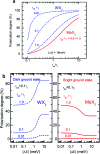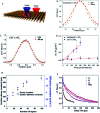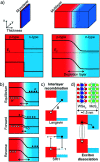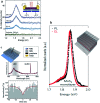Retracted Article: Physics of excitons and their transport in two dimensional transition metal dichalcogenide semiconductors
- PMID: 35530097
- PMCID: PMC9070122
- DOI: 10.1039/c9ra03769a
Retracted Article: Physics of excitons and their transport in two dimensional transition metal dichalcogenide semiconductors
Abstract
Two-dimensional (2D) group-VI transition metal dichalcogenide (TMD) semiconductors, such as MoS2, MoSe2, WS2 and others manifest strong light matter coupling and exhibit direct band gaps which lie in the visible and infrared spectral regimes. These properties make them potentially interesting candidates for applications in optics and optoelectronics. The excitons found in these materials are tightly bound and dominate the optical response, even at room temperatures. Large binding energies and unique exciton fine structure make these materials an ideal platform to study exciton behaviors in two-dimensional systems. This review article mainly focuses on studies of mechanisms that control dynamics of excitons in 2D systems - an area where there remains a lack of consensus in spite of extensive research. Firstly, we focus on the kinetics of dark and bright excitons based on a rate equation model and discuss on the role of previous 'unsuspected' dark excitons in controlling valley polarization. Intrinsically, dark and bright exciton energy splitting plays a key role in modulating the dynamics. In the second part, we review the excitation energy-dependent possible characteristic relaxation pathways of photoexcited carriers in monolayer and bilayer systems. In the third part, we review the extrinsic factors, in particular the defects that are so prevalent in single layer TMDs, affecting exciton dynamics, transport and non-radiative recombination such as exciton-exciton annihilation. Lastly, the optical response due to pump-induced changes in TMD monolayers have been reviewed using femtosecond pump-probe spectroscopy which facilitates the analysis of underlying physical process just after the excitation.
This journal is © The Royal Society of Chemistry.
Conflict of interest statement
There are no conflicts to declare.
Figures











Similar articles
-
Exciton Dynamics, Transport, and Annihilation in Atomically Thin Two-Dimensional Semiconductors.J Phys Chem Lett. 2017 Jul 20;8(14):3371-3379. doi: 10.1021/acs.jpclett.7b00885. Epub 2017 Jul 11. J Phys Chem Lett. 2017. PMID: 28661147
-
Exciton Relaxation Cascade in two-dimensional Transition Metal Dichalcogenides.Sci Rep. 2018 May 29;8(1):8238. doi: 10.1038/s41598-018-25906-7. Sci Rep. 2018. PMID: 29844321 Free PMC article.
-
Exciton-to-trion conversion as a control mechanism for valley polarization in room-temperature monolayer WS2.Sci Rep. 2020 Oct 15;10(1):17389. doi: 10.1038/s41598-020-74376-3. Sci Rep. 2020. PMID: 33060773 Free PMC article.
-
Theory of Excitons in Atomically Thin Semiconductors: Tight-Binding Approach.Nanomaterials (Basel). 2022 May 6;12(9):1582. doi: 10.3390/nano12091582. Nanomaterials (Basel). 2022. PMID: 35564291 Free PMC article. Review.
-
Interlayer Excitons in Transition Metal Dichalcogenide Semiconductors for 2D Optoelectronics.Adv Mater. 2022 Jun;34(25):e2107138. doi: 10.1002/adma.202107138. Epub 2022 Jan 5. Adv Mater. 2022. PMID: 34700359 Review.
Cited by
-
Ultrafast transient sub-bandgap absorption of monolayer MoS2.Light Sci Appl. 2021 Jan 29;10(1):27. doi: 10.1038/s41377-021-00462-4. Light Sci Appl. 2021. PMID: 33514690 Free PMC article.
-
Plasmon-exciton couplings in the MoS2/AuNP plasmonic hybrid structure.Sci Rep. 2022 Dec 23;12(1):22252. doi: 10.1038/s41598-022-26485-4. Sci Rep. 2022. PMID: 36564476 Free PMC article.
-
Hot Carrier Cooling and Trapping in Atomically Thin WS2 Probed by Three-Pulse Femtosecond Spectroscopy.ACS Nano. 2023 Apr 11;17(7):6330-6340. doi: 10.1021/acsnano.2c10479. Epub 2023 Mar 20. ACS Nano. 2023. PMID: 36939760 Free PMC article.
References
Publication types
LinkOut - more resources
Full Text Sources

